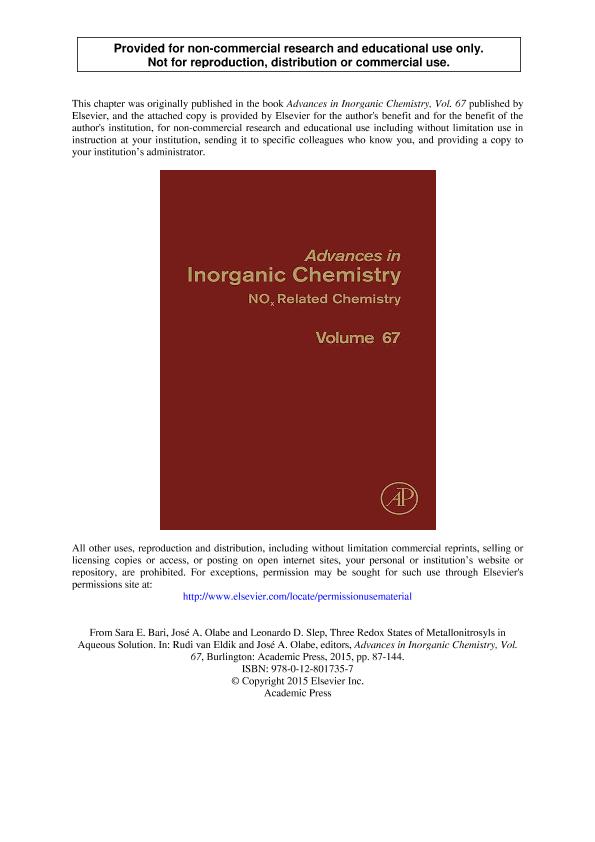Mostrar el registro sencillo del ítem
dc.contributor.author
Bari, Sara Elizabeth

dc.contributor.author
Olabe Iparraguirre, Jose Antonio

dc.contributor.author
Slep, Leonardo Daniel

dc.date.available
2018-09-10T16:06:48Z
dc.date.issued
2015-12
dc.identifier.citation
Bari, Sara Elizabeth; Olabe Iparraguirre, Jose Antonio; Slep, Leonardo Daniel; Three redox states of metallonitrosyls in aqueous solution; Elsevier Academic Press Inc; Advances In Inorganic Chemistry; 67; 12-2015; 87-144
dc.identifier.issn
0898-8838
dc.identifier.uri
http://hdl.handle.net/11336/58877
dc.description.abstract
This contribution deals with the structure and reactivity of bound nitrosyl in transition-metal centers (group 8: Fe, Ru, Os). The focus is set on pseudooctahedral nitrosyl-complexes with coordination number 5 and 6, containing ancillary coligands of both heme- and nonheme type. The discussion is organized in terms of Enemark and Feltham's classification, selecting complexes within the {MNO}n framework (n=6, 7, and 8). The examples have been chosen for a best description of the electronic structures in terms of modern structural, spectroscopical, and computational methodologies. The selected {MNO}6,7,8 species reflect the occurrence of three redox states of bound nitrosyl, frequently (though not always) described as NO+, NO, and NO- for n=6, 7, and 8, respectively. The analysis is centered on the members of a series of complexes for which the three redox states have been observed on the same platform, viz., [Fe(CN)5(NO)]2,3,4- and [Ru(Me3[9]aneN3)(bpy)(NO)]3,2,1+, in aqueous solutions. The influence of the donor-acceptor character of the coligands is specifically addressed with emphasis on the ligand trans- to nitrosyl, showing that the latter group may exert a delabilizing influence (as NO+), as well as a labilizing one (NO-≫NO) on the trans-ligand. On the other hand, typical electrophilic reactivity patterns (toward different nucleophiles) are analyzed for M-NO+, and nucleophilic reactivity (with O2) is described for the reduced species, M-NO and M-(NO-). In the latter case, protonation is described by characterizing the bound HNO species. Important differences are highlighted in the chemistry of bound NO- and HNO, revealing the strong and mild reductant abilities of these species, respectively. The chemistry is analyzed in terms of the biological relevance to the behavior of nitrite- and NO-reductases and other NO-related enzymes.
dc.format
application/pdf
dc.language.iso
eng
dc.publisher
Elsevier Academic Press Inc

dc.rights
info:eu-repo/semantics/openAccess
dc.rights.uri
https://creativecommons.org/licenses/by-nc-sa/2.5/ar/
dc.subject
Nitrosyl
dc.subject
Nitrosyl Hydride
dc.subject
Nitroxyl
dc.subject
No-Complexes
dc.subject.classification
Otras Ciencias Químicas

dc.subject.classification
Ciencias Químicas

dc.subject.classification
CIENCIAS NATURALES Y EXACTAS

dc.title
Three redox states of metallonitrosyls in aqueous solution
dc.type
info:eu-repo/semantics/article
dc.type
info:ar-repo/semantics/artículo
dc.type
info:eu-repo/semantics/publishedVersion
dc.date.updated
2018-09-04T19:04:56Z
dc.journal.volume
67
dc.journal.pagination
87-144
dc.journal.pais
Estados Unidos

dc.journal.ciudad
Burlington
dc.description.fil
Fil: Bari, Sara Elizabeth. Consejo Nacional de Investigaciones Científicas y Técnicas. Oficina de Coordinación Administrativa Ciudad Universitaria. Instituto de Química, Física de los Materiales, Medioambiente y Energía. Universidad de Buenos Aires. Facultad de Ciencias Exactas y Naturales. Instituto de Química, Física de los Materiales, Medioambiente y Energía; Argentina. Universidad de Buenos Aires. Facultad de Ciencias Exactas y Naturales. Departamento de Química Inorgánica, Analítica y Química Física; Argentina
dc.description.fil
Fil: Olabe Iparraguirre, Jose Antonio. Consejo Nacional de Investigaciones Científicas y Técnicas. Oficina de Coordinación Administrativa Ciudad Universitaria. Instituto de Química, Física de los Materiales, Medioambiente y Energía. Universidad de Buenos Aires. Facultad de Ciencias Exactas y Naturales. Instituto de Química, Física de los Materiales, Medioambiente y Energía; Argentina. Universidad de Buenos Aires. Facultad de Ciencias Exactas y Naturales. Departamento de Química Inorgánica, Analítica y Química Física; Argentina
dc.description.fil
Fil: Slep, Leonardo Daniel. Consejo Nacional de Investigaciones Científicas y Técnicas. Oficina de Coordinación Administrativa Ciudad Universitaria. Instituto de Química, Física de los Materiales, Medioambiente y Energía. Universidad de Buenos Aires. Facultad de Ciencias Exactas y Naturales. Instituto de Química, Física de los Materiales, Medioambiente y Energía; Argentina. Universidad de Buenos Aires. Facultad de Ciencias Exactas y Naturales. Departamento de Química Inorgánica, Analítica y Química Física; Argentina
dc.journal.title
Advances In Inorganic Chemistry

dc.relation.alternativeid
info:eu-repo/semantics/altIdentifier/doi/https://dx.doi.org/10.1016/bs.adioch.2014.10.001
dc.relation.alternativeid
info:eu-repo/semantics/altIdentifier/url/https://www.sciencedirect.com/science/article/pii/S0898883814000026
Archivos asociados
